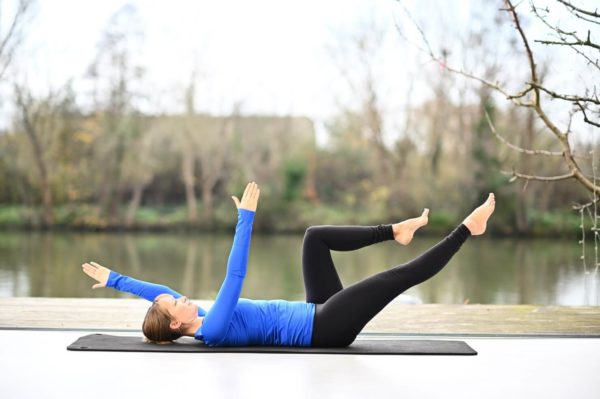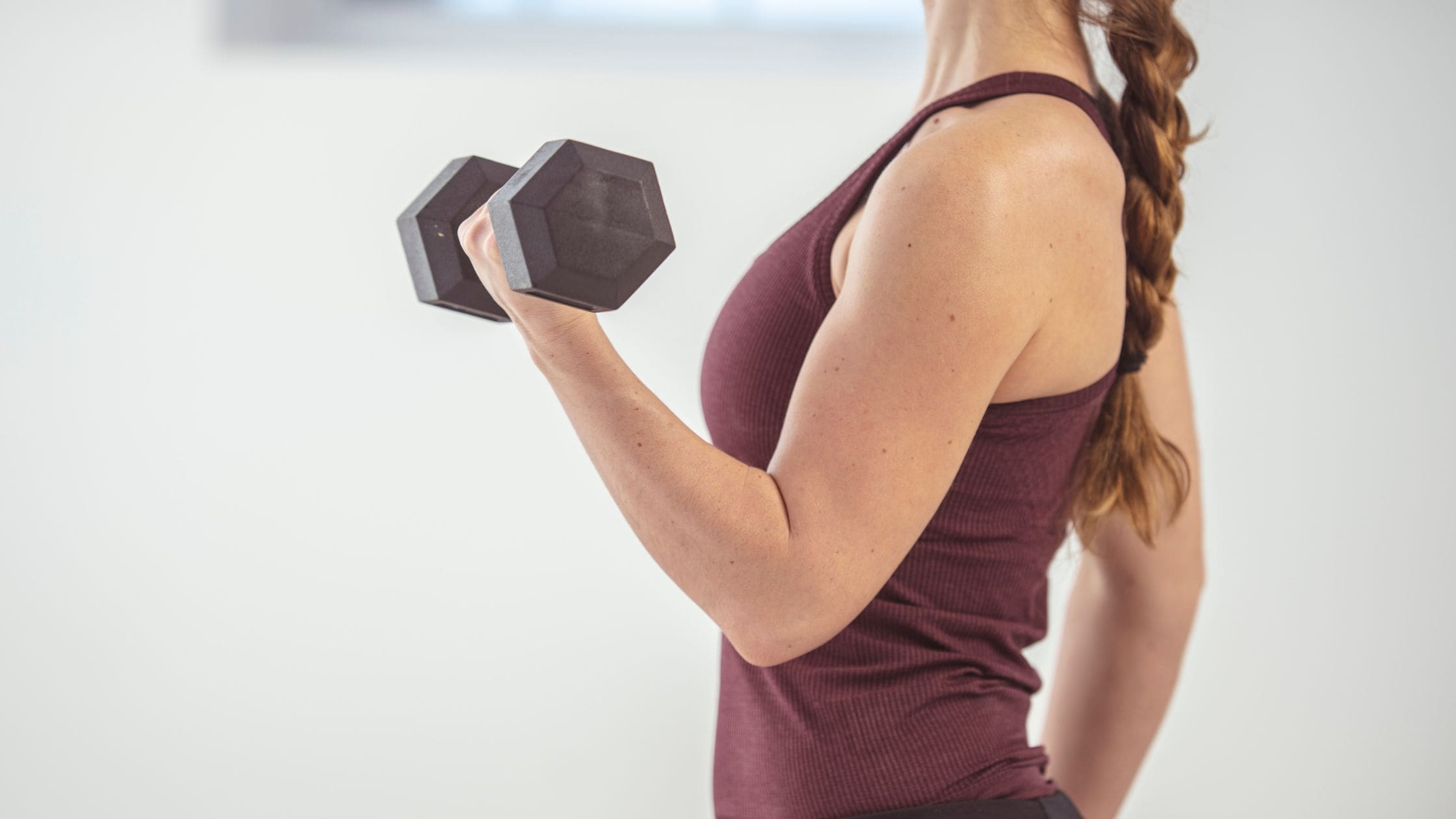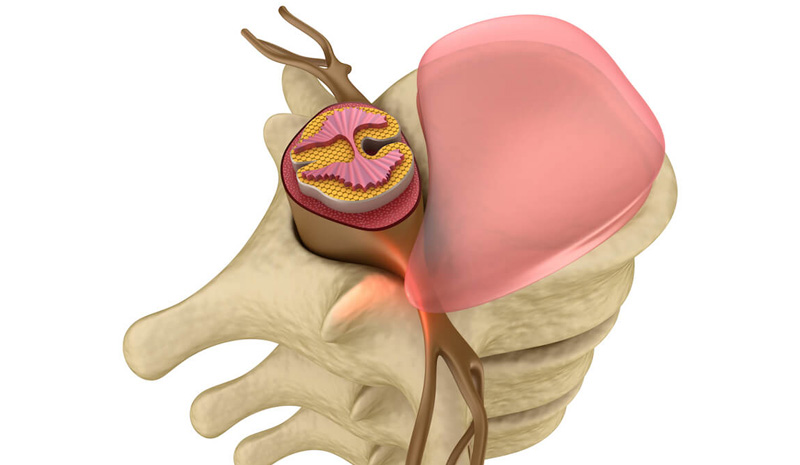The dead bug exercise will help you improve your pelvic stability, activate your deep abdominal muscles, and help you learn how to differentiate the movement between your hips, pelvis and lower spine. Perfect for creating a strong base!
Incorporating core moves into your workout routine is essential for improving your overall strength. If you play lots of sports such as tennis or basketball where you have to extend opposing limbs or stretch, jump or reach for a ball then it is important to have a strong core to make these types of movements possible.
But it’s not just athletes who need back-protecting core stabilisation – essentially everyone does. You use your core for everything in your day-to-day life such as getting out of bed, walking to work, and picking up your shoes from the floor. It’s the base that supports your entire body.
And, the dead bug exercise can help you understand this.
In this article, we’ll be discussing:
- What is a dead bug?
- How to do a dead bug?
- What are the benefits of the dead bug exercise?
- Who is the dead bug exercise suitable for / not suitable for?
What is a dead bug?
The dead bug is a beginner-friendly movement that’s excellent for overall basic core stability. It targets multiple core muscles (including those hard-to-reach deep core transverse abdominis), without putting strain on your lower back. Ultimately, it focuses on building up core strength whilst keeping the spine neutral and pelvis quiet.
Simply put, the dead bug is a supine abdominal exercise. Meaning it is carried out lying down on the back.
As you keep your torso quiet and continue to breathe, you extend and retract your legs. The aim is to prevent your lower back from arching off the floor or pushing into it. You are trying to breathe through the exercise so you don’t brace in your core but work it through full range.
Once you’ve mastered the dead bug and can easily do a few sets, you can progress to more advanced variations or build up to a longer routine with variations ranging in difficulty.
What muscles do dead bugs work?
- Rectus abdominis (your ‘six pack’ muscles)
- Transverse abdominis (deep core),
- Lower back
- Obliques (sides)
- Hip flexors
- Pelvic floor
- Diaphragm to name a few
How to do the dead bug exercise
The dead bug exercise is commonly used in Pilates as a perfect way to create a strong base, improve your pelvic stability and activate those deep abdominal muscles. It also helps you understand how to differentiate the movement between your hips, pelvis and lower spine. This is what needs to happen when you walk, move from sitting to standing or go up and down stairs!
- Lie on your back with your feet flat on the floor and knees bent.
- Legs should be bone distance apart – this is often narrower than you think!
- Do use a pillow underneath your head for support if you feel your head is extending backwards.
- Let your arms rest by your sides with your palms facing up or down.
- Let your sit bones relax so that you come into your ‘neutral spine’ position. Make sure you feel that natural tiny gap behind your lower back and the mat.
- If you are doing this for the first time, use your breath to help you move and create stability.
- On an exhale, lift one leg up to table top – when the thigh bones are perpendicular to the floor and shins are roughly parallel to the floor.
- Pause on the inhale and exhale as you lower the leg.
- Try to move from your hip joint and keep the bend at your knee the same.
- Repeat this a few times, and when you are happy try inhaling the leg up and exhaling the leg down and do a few more.
- The aim is to keep the breath even and your stomach rising and falling as you breathe.
- Repeat on the other side
Dead bug top tips
Try to use as little effort as possible throughout the movement.
★ It’s all in the hips!
This movement is about hip extension! Try to avoid simply bending the knee to tap the toe to the floor. Instead, keep the bend at the knee the same and move from your thigh bone.
★ Keep the pelvis still and in neutral throughout the movement.
If you can feel your way through a good quality pelvic clock without it hurting your back, you can start to feel where your ‘neutral spine’ is. Remember, this is a fluid concept and changes depending on the position you are in.
★ Find your heavy parts.
Find the heaviness in the back of your head, ribs and tail bone. Then, instead of concentrating on the front, see whether you can keep the weight in these areas the same. This will help to tell you whether you are forcing yourself to imprint your spine, or increasing the arch.
★ Can you hold a conversation?
To know if you are bracing it is not just about whether you are breathing or holding your breath…although knowing this definitely helps! Can you hold a conversation without your voice sounding strained? Do you feel tension building up in your neck? Are you gripping with your arms? All these things can contribute to bracing. If the answer is yes to any of these, reduce your range and focus on quality!
★ Find your core
This always comes with your breath so that you are working the whole core, including your pelvic floor and diaphragm. To find your pelvic floor, exhale and imagine you are zipping up internally from your back passage, to your front passage up to your tummy button. If you are male, imagine you are lifting your testicles and penis up. Next, feel your hip bones gently draw together to create light tension across your stomach. This should increase as you breathe and start gradually. Finally, allow your rib cage to move on both the inhale and exhale.
Pilates dead bug exercise progression

- Progress with a full dead bug!
- Lie down flat on your back with your arms extended toward the ceiling and your feet off the floor into table top (knees bent to 90 degrees).
- As you exhale, slowly lower one foot until that toe nearly touches the floor, while at the same time lowering the opposite arm to the floor overhead.
- Inhale to return both arm and leg to start position and repeat with the opposite arm and leg.
- If you want to make the move harder, try gripping a resistance band between both hands, or, adding in weighted ankle straps or dumbbells.
- You can also make it harder by moving the same side arm and leg or moving slowly to extend and bringing it back in quicker.
What are the benefits of a dead bug?
As already highlighted, dead bugs help to maintain strength and stability in the core, spine and back muscles which in turn helps to improve posture and play a part to relieve and prevent lower back pain.
Building up awareness of your core is great for balance and the dead bug exercise is also great coordination especially when progressing to the more advanced variations; the advanced progression arm and leg combinations improves spine stabilisation and builds up strength in your hip flexors.
By doing dead bugs you may find you have the awareness and stability to move better during daily and athletic activities.
Who is a dead bug suitable for?
Dead bugs are excellent for anyone looking to improve and strengthen their core but they are particularly good to include as a warm up for runners and swimmers, people who play sports such as basketball or tennis, women who may be pregnant or who’ve just had a baby or those with back pain.
Dead bugs is also a recommended exercise for:
- people with arthritis
- older adults working on improving muscle function
- people with chronic pain
- people with Parkinson’s disease to make everyday activities easier and prevent injuries and accidents with a big base of support
Who is a dead bug not suitable for?
Anyone who has a known irritable lower-back injury should avoid this exercise if it causes pain. Sharp or jabbing pains, or any type of discomfort is what you want to avoid. You should consult with an exercise specialist, like a Clinical Pilates Instructor for individual advice if a dead bug just isn’t working for you.
Overall, the dead bug is a safe exercise for most people. However, if your form starts to suffer, it’s likely because your muscles are tired. Poor form won’t help your efforts to get stronger, and may, in fact, lead to injury.
Why do a dead bug?
As you should know by now the dead bug exercise is ideal for developing basic core strength which can help with overall stability and play a part in preventing lower back pain.
It can be done on its own, as part of a core strengthening routine, or along with other exercises and the variations make it easy to find the exercises that work best for you.
At Complete Pilates we would advise you to always speak to your doctor before starting an exercise routine and especially if you have any health concerns or are new to fitness.
If you would like more information about how to do dead bugs or would like to know how Pilates can help you build your core strength then talk to a Clinical Pilates instructor here at Complete Pilates. Our team is trained to safely treat clients and create manageable, appropriate, on-going exercise plans to keep you healthy.
We are also able to refer you to other specialist partners if we feel you are at higher risk and need further investigations or medical input. Get in touch online or contact us on 0203 764 5668 for further information.
These blogs are designed to give information to everyone, however, it is important to remember that everyone is different! If you have not seen one of our therapists and have any questions about injuries, what you have read or whether this may be useful to you, please just ask. We are more than happy to help anyone and point you in the right direction. Our biggest belief is that education is key. The more you understand about your injury, illness and movement, the more you are likely to improve.





